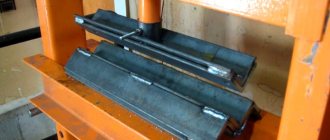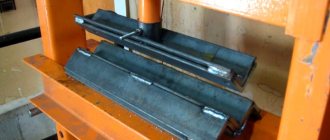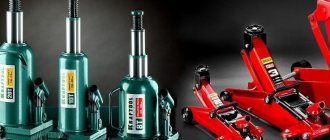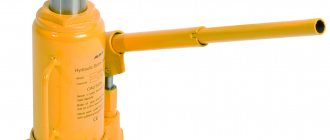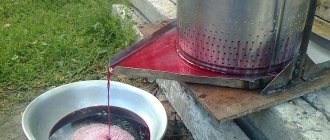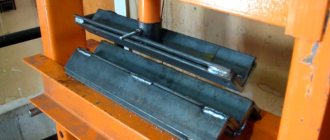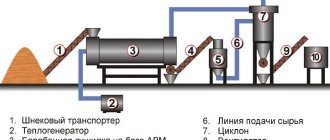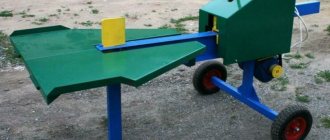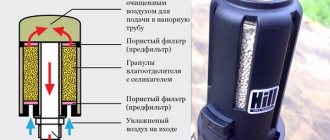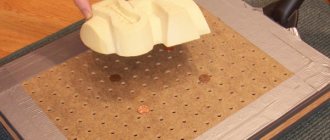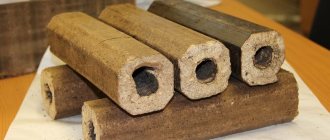To process oilseeds, special equipment is used - an oil press. By using such a simple device, which some craftsmen make with their own hands, at home or in small-scale production, you can obtain an environmentally friendly product that is superior in taste and healthiness to oils sold in stores. The technical characteristics and design of the equipment used depend on which plant crops and in what quantities the oil must be obtained.
To obtain oil for your needs, it is enough to acquire a device whose design is quite simple
Homemade oil production
Let's tell you a little about how you can make oil dishes for obtaining olive or sunflower oil with your own hands and what features there are in these matters.
- Mini oilers for pressing allow you to produce oil that is suitable for consumption for two years. You can assemble the device yourself or buy special presses for household use.
- Homemade oilers are designed to produce products from sunflowers, olives or seeds with nuts. It all depends on what kind of oil you need.
- The easiest way to make wringer oilers with your own hands is to adapt a mechanical press. Previously, they sold a hand press, with the help of which they squeezed juice out of grapes and apples. To obtain olive oil using the pressing method, you don’t even need to change attachments. The holder is replaced with a device with increased power. This will allow you to use the unit as a press for squeezing sunflower oil or olive oil, beloved by many.
- If you can’t purchase a manual squeezing press, you can make the device yourself using improvised means. A homemade press involves the use of a worm screw for pressing. The pressure generated depends on the power of the beam risers and the diameter of the worm nut. It is recommended to make a beam with a power reserve. The best option is an oak mechanism. If you cannot assemble an oak unit, you can use a metal structure.
- The design provides for a cylinder without a bottom. It is made or made from part of a barrel. It is recommended to strengthen the structure from below with an additional metal hoop. The main thing is that the material is dry and made from hardwood. An oak cylinder would be the ideal solution.
- Peeling spin rollers. This is a pair of replaceable rollers that rotate due to gears. The gears are mounted on metal racks and buckets - upper and lower - are fixed to them. There is also a handle for rotation or a toggle lever. All this is assembled from scrap metal. Only the rollers are made of wood and lined with grater cloth.
How does he work
Having a ready-made design and replaceable squeezing attachments, you can start making sunflower or olive oil.
- A seed is poured into the ladle;
- The handle sets in motion the mechanism that acts on the seeds with a grater;
- The seeds end up in the gap between the rollers, due to which the peeling process occurs;
- The kernels and husks end up in the lower bucket;
- The mixture is collected and winnowed;
- Roller attachments are replaced with smooth spin devices;
- The mixture is again placed in the upper ladle for rolling;
- The corresponding lever is moved to the second position to disengage the gear. Now it will rotate freely in the direction of the second gear, pressing and squeezing the seeds;
- As a result of rolling, a mushy mass is formed, which is sent for pressing.
The output percentage of finished products is not as high as with specialized equipment. This is due to the fact that the nozzles of a home oiler operate with insufficient pressure. This can be corrected using a hydraulic press or an electric motor.
Important advantages are the minimal cost of constructing an oiler and obtaining a high-quality natural product by pressing.
For home use, you can purchase a wooden unit or an auger. Both the wooden and screw type oilers have excellent efficiency. A screw unit will cost approximately 13-15 thousand rubles, and for a wooden hydraulic press you will have to pay at least 50 thousand rubles. But if you use the resulting oil not only for yourself, but also sell it to friends or acquaintances, over time, buying an oil can will completely justify itself.
Even with a mini oiler, you can organize a small business producing cold-pressed olive oil or the most popular sunflower oil.
Butter churn: household electric, manual, wooden antique
Butter is a long-loved product among the Slavic peoples. And if previously it was prepared in every home, today it is sold in every store. A truly unique creamy taste is obtained only through our own production process. And before that, a suitable churn is selected or manufactured.
How does a butter churn work?
Butter churn is special equipment for the production of butter from cream, full-fat sour cream or other dairy products.
The principle of operation of a butter churn is to destroy the shells of fats contained in milk. The molecules stick together and become compacted, forming a solid mass. You can destroy the shells by vigorously beating. The automated process allows you to obtain a homogeneous oil structure, without air bubbles and layering.
The description of the first devices dates back to the III century. BC e. The Sumerian stones at El Obeida depict the process of skimming milk and churning the product. In "Russian Truth" XI Art.
the extensive trade in butter is described, which forced Peter I to impose taxes on this area.
The process of creating a dairy product is also indicated: producing sour cream by fermenting milk, intensively whipping using a whorl in a deep container.
The main point for obtaining high-quality oil is not even the efficiency of the churn, but the quality of the raw materials. A suitable option is farm or homemade cream.
But they require a mandatory pasteurization process to protect consumers from possible harm from bacteria contained in milk.
A safe option is already pasteurized store-bought cream, but, as practice shows, the resulting product will not have a rich creamy taste and aroma.
It is also worth paying attention to the maturity of the cream. Unripe raw materials produce a soft product with a lower percentage of fat, while overripe raw materials produce a coarse product that cooks slowly.
The buttermilk waste that comes out during the butter making process is buttermilk, a fat-free liquid component. It is also used in the production of food products: baked goods, dietary cheeses, cereals.
At oil factories producing various types of products, there is a churn for sunflower oil. This is a massive and complex device that presses out sunflower seeds. The result is a healthy cold-pressed oil that retains important properties. Waste is pressed cake, which serves as animal feed, raw material in cosmetology, and occasionally in cooking.
Which one is better to choose?
Despite the fact that the procedure for producing butter seems far from everyday life, there are many devices on the market from which you can choose one suitable for industrial purposes or for preparing a dairy product for the family.
For home use, you can purchase a manual or electric butter churner. A comparison of the two types of equipment can be found in the table below.
Comparison criterionManual butter churnElectric butter churn
Price[/td]
| Low | High | |
| Volume | Less | More |
| Material | Wood, plastic | Metal, plastic |
| Impeller rotation speed | Limited by human capabilities | 900-1400 rpm |
The first option is suitable for people who are devoted to traditions or want to completely control the process. A wooden container is durable, but more difficult to clean.
In addition, if low-quality raw materials are used, it can get wet and will not be durable.
Plastic devices can quickly become damaged, but those made from high-quality raw materials are more comfortable to use: transparent walls allow you to monitor the consistency, and a smooth surface allows you to quickly clean the container.
A household butter churn requires the following churning technique:
- Fill the bowl 2/3 full with cool cream. It is recommended to pre-stand the product
- Close the lid. Start the beating process. Depending on the fat content of the cream, it lasts from 20 to 40 minutes.
- Check every 30-40 seconds. When large dense lumps appear, stop the churn.
- Drain the buttermilk.
- Let a piece of butter drain and rinse with cold water.
An electric butter churn is a common option. It does not require physical effort, but concentration and close attention to the process are required. There are two types of electrical appliances: monoblock (solid) and consisting of 2 parts. In the first case, the engine is built into the working tank. The second option is more convenient, which consists of an impeller (together with a motor) and a bowl for cream.
Engine power and the number of impeller revolutions are important criteria for selection if you want to produce a dairy product on a large scale. It is worth remembering that a powerful engine requires more energy.
The technique for working with this equipment is similar:
- Prepare the cream. Pour in a third or two-thirds of the container (it is important to read the instructions first).
- Beat. Check every 15-30 seconds. It is necessary to remove or turn off the engine every time, otherwise there is a risk of staining the entire kitchen.
- If lumps appear, remove the buttermilk, knead and rinse a piece of butter.
Electric means are characterized by whipping speed and ease of use.
There are also improved models, for example, a separator-churn. The device allows you not only to whip butter, but also to separate cream from milk.
A homemade butter churn is an alternative to expensive and complex devices. Options for creating the product yourself:
- a screwdriver with a whisk attached to it;
- a device on a motor that rocks the jar (the product is whipped against the glass walls);
- deep mortar with a lid, a toothed whisk is lowered into the hole in the lid.
It’s not difficult to create a butter churn with your own hands, but the productivity of the device is low, and there is a risk of dirtying kitchen equipment or harming your own health (for example, when using a screwdriver).
A home creamery is a suitable way to make healthy, natural butter. But it is important for her to choose the right equipment - a butter churn. Selection criteria are goals and personal preferences. For rare, “exclusive” production, a manual device is suitable; for mass, commercial production, an electric device is suitable.
Did you find useful information for yourself? Want to read more about this topic? Like ♥, subscribe to our channel and you will be one of the first to know about new publications!
And if you have something to share, leave your comments! Your feedback is very important to us!
Spin methods
Before choosing oil extraction devices, you need to decide what type of oil product you are targeting. There are two ways to obtain this sought-after liquid.
- Hot pressed oil. Before squeezing, the mushy mass is heated to a temperature of 110 degrees Celsius. At the same time, the mint is moistened and mixed in roasting pans. After this, the screw mechanism compresses the raw materials. The hot-pressed product has the taste of roasted sunflower seeds. This oil is darker, has an attractive color and an amazing aroma.
- Cold pressed oil. Cold-pressed products are considered more useful, since some properties and useful components of the raw materials are not lost when heated. The essence of cold pressing is the absence of the stage of heating the raw materials. Cold-pressed liquid retains all the beneficial substances and vitamins. But the shelf life is lower. Over time, the oil darkens and acquires a bitter taste.
Homemade butter recipe
Previously, when there were no mixers or even whisks, butter was prepared by hand. Of course, this cooking technology takes much more effort and time, however, in this case the oil turns out to be especially soft and uniform.
To create such a product you will need a liter of heavy cream.
- To mix better, the cream should stand in a warm room for an hour. Next, the cream is poured into a deep bowl and kneaded in the same way as the dough.
- After some time of continuous intensive stirring, the cream will acquire a grainy consistency. After some time they will begin to turn into an oily mass.
- When this mass becomes more or less tight, the oil must be thoroughly squeezed out of the liquid. Some, in this case, rinse it under cool water.
- Then the oil must be transferred to a closed container and refrigerated.
Features of modern devices
Having decided between the cold and hot pressing method, you can proceed directly to the selection of equipment for production.
In our country, the production of olive oil is problematic, since there is no access to a large amount of appropriate raw materials. The production of olive oil is less profitable than sunflower oil. But the choice is yours.
For active production of these products, appropriate equipment will be required. The optimal solution with an eye to the future is the purchase of modern production complexes. The uniqueness of modern developments lies in the fact that they have different attachments and functionality. At the same time, the device, which is a production line, takes up minimal space.
This mini complex for the production of sunflower oil performs the main stages of raw material processing without the need for additional devices.
- First, the raw materials go through the mandatory stage of drying and removing all kinds of contaminants. Appropriate attachments remove foreign objects from the seeds.
- Next, the raw material goes to cleaning, where nozzles separate the kernels from the husks. After this, the products are crushed.
- The resulting pulp is steamed and fried if we are talking about the hot pressing method.
- When the pre-treatment is completed, the prepared mass is pressed.
- The resulting oil then passes through filter devices. This allows you to obtain the purest and highest quality oil possible.
- After pressing, the liquid is packaged in appropriate containers and sent for storage for further sale.
It is not difficult to obtain oil by pressing even at home. To do this, you can build a special device or purchase factory equipment aimed at producing oil by cold or hot pressing.
Source: tvoistanok.ru
A quick recipe for making homemade butter
To prepare this oil you need:
- mixer,
- sieve,
- deep bowl and spatula,
- The only ingredients you need are heavy cream.
How to make homemade butter?
- Before cooking, the cream must be cooled to approximately 10 degrees.
- Then, the cream is poured into a mixer with a whisk, and the lid is tightly closed. The mixer must be turned on at medium-high speed and beat for about 7-10 minutes. When the cream begins to whip into a thick mass, releasing liquid, the speed can be reduced slightly.
- When the oil stops releasing liquid, the mixer must be turned off. Next, the oil along with the liquid is filtered through a sieve. The resulting liquid, buttermilk, can be used to make baked goods, pancakes or pancakes.
- After this, the resulting oil should be transferred to a deep bowl and mixed thoroughly. It is advisable to do this using a wooden mortar or spatula, then the product will be especially soft.
The prepared butter should be stored in a closed container in the refrigerator.
Homemade oil press
To obtain oil industrially, the seeds are filled with gasoline fractions. Hexane, for example. When oil is formed from the seeds, this hexane is removed using steam, and its remains are removed with alkali. At the exit, various undesirable substances appear in the finished product: resins and pigments. Residual solvents are rarely completely evaporated.
Before the oil obtained by extraction can be consumed as food or used in medicine, it needs to go through several more stages of purification: refining, then hydration, then bleaching, then deodorization and finally a couple more filtration steps.
Butter churn to the rescue
Not everyone can beat a natural product on their own, but butter in a churn is a win-win option. To prepare you will need:
- Cream. The main ingredient that needs to be kept cool for several days, but not more than 72 hours.
- Separator. Using this device, cream is separated from milk; it can be used either manually or automatically.
- Churn. Homemade butter in a churn turns out elastic, tasty and tender.
Separate the cream from the milk using a separator, let it settle, then pour it into the churn and turn it on. In half an hour the oil will be ready. After whipping, it is not recommended to immediately take out the butter; you need to leave it for a few minutes so that the buttermilk has time to drain. It is better to wash the resulting product with milk so that the taste is not lost.
The container for sealing must be dry and clean, rubbed inside with salt. For long-term storage, melt the butter in a cast-iron bowl and skim off the resulting foam with a wooden spoon. When the oil becomes transparent, this is the final sign of readiness.
Cold pressed oil press: DIY and home use
To process oilseeds, special equipment is used - an oil press. By using such a simple device, which some craftsmen make with their own hands, at home or in small-scale production, you can obtain an environmentally friendly product that is superior in taste and healthiness to oils sold in stores. The technical characteristics and design of the equipment used depend on which plant crops and in what quantities the oil must be obtained.
To obtain oil for your needs, it is enough to acquire a device whose design is quite simple
Design Features
Producing vegetable oil at home using a purchased or self-made press has a number of features that must be taken into account.
- When producing oil at home, the finished product has a two-year shelf life. A home press can be purchased in a serial version or made by yourself.
- Using a household squeeze press, you can extract oil from sunflower seeds, olives and even nuts.
- One of the simplest and most cost-effective ways to make a device for extracting oil is to remake a serial household press designed for squeezing juice from grapes and apples. In such equipment there is no need to change working attachments - it is enough to replace the holder with a device of higher power. This modernization will allow the unit to be used not only for processing olives, but also for squeezing oil from sunflower seeds.
- A home oil press, the basis of which is a worm screw responsible for pressing, can be made using improvised means. When designing such a press, keep in mind that the pressure it will be able to develop will depend on both the diameter of the worm nut and the power of the beam risers. To provide the created device with higher reliability, the beam that serves as the basis of its structure should be made more powerful. These requirements are fully met by a wooden oil press, the mechanism elements of which are made of solid oak. A budget alternative to such a unit is a press, the structural elements of which are made of metal.
- A household press (like any other) used for squeezing oil requires a cylinder without a bottom in its design, which can be used as an ordinary metal barrel. To increase the rigidity of such a cylinder in its lower part, you can take a metal hoop. If a wooden barrel is used as a cylinder, the material from which it is made must be dry and highly hard. The ideal material in this case would be solid oak.
- Important design elements that an oil press should be equipped with include the peeling rollers, which are a pair of replaceable rollers. Their rotation is ensured by gears mounted on the metal racks of the device. On the racks, in addition to the gears, the upper and lower buckets are fixed, as well as a handle, which ensures the rotation of the mechanism elements, or a toggle bucket. Peeling rollers are usually made of wood, and their working surface is lined with a float cloth.
Recipe for making butter
|
Operating principle
Once the wooden oil press (or metal) is assembled and equipped with replaceable attachments, you can begin to use it for its intended purpose. To extract oil using such a unit (for example, from sunflower seeds), you must perform the following steps:
- Raw materials are poured into the loading ladle of the device.
- The rollers, the surface of which is covered with a grater cloth, are driven into rotation by means of a handle.
- Due to the rotation of the rolls, the raw material is drawn into the gap between them, where the peeling occurs.
- After peeling, the sunflower kernels and the husk from which they are freed end up in the lower bucket.
- The mixture consisting of sunflower kernels and husks is winnowed.
- Rollers with a grater cloth are replaced with rollers with a smooth surface, with the help of which vegetable oil will be squeezed out.
- The cleaned seed kernels are placed in the upper bucket and sent to rolling.
- To reduce the size of the gap between the rollers, which is necessary so that the seed kernels passing between them are compressed with the required force, a special lever of the hand press, which is moved to the second position, allows.
- The result of rolling is a mushy mass, which must be pressed to extract the vegetable oil from it.
Manual type wooden hydraulic oil press for squeezing oil from seeds and nuts
Since a manual squeezing press is not able to provide the high pressure exerted on the raw materials used, the percentage of oil yield is lower than when using specialized equipment. If you use an electric motor or a hydraulic press to drive such equipment, you can correct this shortcoming.
A manual oil press has a number of advantages. We present the most significant of them.
- Due to the simplicity of the design, such a press can be made by hand.
- The finished product has excellent taste and high nutritional value.
Manual screw press for home oil extraction
At home or in a small production workshop, you can use both a wooden and a screw press to produce vegetable oil, which are highly efficient. It should be kept in mind: if you do not make such devices for extracting oil yourself, but purchase ready-made models, then a wooden press based on a hydraulic mechanism will cost much more than a screw press. If you take such a unit to organize a small business producing and selling environmentally friendly vegetable oil, it will pay for itself quickly enough. Such equipment will pay for itself even faster if you use it to produce not only sunflower, but also olive or even cedar oil.
Pros and cons of a self-made butter churn
The only advantage of a homemade butter churn is its relative cheapness. Among the disadvantages that should alert every inventor are:
- Difficulty in performing high-quality vessel processing. Washing wooden barrels with water (if they are used) is much more difficult than washing the container of a butter churn. Even if you follow all the rules, it is impossible to guarantee the safety of the product, because pathogenic flora can develop in the dishes.
- Inability to create the correct whipping mode. This will definitely affect the taste of the butter, its fat content and shelf life.
- The need for constant monitoring. The system created by a home craftsman is not always ideal. When using it, you can get injured and create life-threatening situations.
The main danger posed by the use of homemade electrical appliances is an increased fire hazard. Industrially manufactured electric butter churns have several degrees of protection against electric current and are equipped with an emergency shutdown system.
Having assessed all the advantages and disadvantages, modern farmers and owners of small farms prefer ready-made units. Despite the cost, the devices pay for themselves in the shortest possible time, because real homemade butter made from natural cow's milk is always in demand.
What methods are used to extract oil from vegetable raw materials?
Vegetable oils, depending on the extraction method, are divided into two main types, each of which involves the use of a specific technology and appropriate equipment. These types, in particular, are:
- oils obtained by hot pressing;
- cold pressed oils.
Oil extraction area using double hot pressing
If the oil is produced using hot-pressing technology, then the pulp obtained after rolling is placed in special fryers, where it is heated to a temperature of 110° and at the same time moistened. At the same time, the mass is constantly stirred. After such preparation, the raw materials are placed in a screw device, where pressing is performed, as a result of which the oil is released. Vegetable oil obtained using hot-pressing technology is distinguished not only by its beautiful dark golden color, but also by a very bright aroma, as well as the taste of fried seeds.
Meanwhile, cold-pressed vegetable oil is considered more useful, since the raw materials for its production are not subjected to thermal effects, and accordingly, the product retains all its beneficial properties. For cold pressing of oil, a technology similar to that described above is used, only it does not include the stage of heating the pulpy mass that has passed through the rollers. Vegetable oil obtained using cold-pressing technology, although it has more beneficial qualities, has a shorter shelf life, and over time acquires a darker color and a bitter taste.
Homemade oil press – Homemade machines
I received a question from Instagram about the cold-press technology of EcoFarm YAKUSHEV. A good question deserves a good answer and gratitude, so we provide a link to the author’s profile: rodnoy_medok
Question from rodnoy_medok: Tell us how you can fry using extra cold-pressed oil?) After all, there are only three methods of extraction - an oak barrel, a screw press and extraction. You can buy it from a screw press in a store - “cold” pressing and the smell of roasted seeds. Do you have the same?
The answer was prepared with the support of Alexey Yakushev: Dear rodnoy_medok, thank you for the wonderful question, because many people only know about the existence of refined and unrefined oil, and even unrefined oil can be different. So let’s put harmful refined oils aside and consider the technologies for the production of unrefined vegetable oil.
Like presses made from other types of wood, oak presses are very beautiful, and during the production process they emit an incomparable aroma and the oil flows so deliciously that you can admire it, but everything is so rosy only before they begin to be actively used.
The main disadvantages of wooden oil presses:
- low performance. On average, 1-3 liters per hour, which means even with a 12-hour working day you can’t get more than 36 liters of oil
- low oil yield - about 20% of the weight of the seed
- rancidity, drying and fungus. When the cash press is idle, it must be cleaned and treated with beeswax.
If this is not done, then the oil remaining on the surface of the wood will dry out, go rancid, and the new smell will no longer be eradicated from the old barrel. If the press is not dried, then mold may grow on wooden surfaces, which also will not make the oil useful and environmentally friendly. - High cost or low quality oil. If the equipment is used regularly, without downtime and is cleaned and dried in a timely manner, then problems with its damage can be avoided, but who can vouch for an unknown manufacturer, especially when every preventive maintenance means equipment downtime, a waste of time, and therefore an increase in cost.
Screw oil presses are more technologically advanced and can operate in continuous mode for a long time. They also require cleaning, but metal is easier to clean than wood. However, screw presses have no fewer pitfalls than wooden ones.
Production equipment
Even high-performance equipment designed for producing vegetable oil in industrial conditions is small in size and, accordingly, does not require much space for installation. Modern models are often mini-complexes for the production of vegetable oil, equipped with various working modules, which significantly expands their functionality.
Screw oil press, designed for cold continuous extraction as part of a production line or as an independent device
Thus, a typical sunflower oil production line operates according to the following principle.
- The raw materials must be dried, cleaned of various contaminants, and foreign impurities are removed from them.
- In a special module, the seed kernels are separated from the husks and crushed.
- The crushed seed kernels are steamed, and if we are talking about hot pressing, they are also fried.
- The oil is squeezed out from the prepared mass.
- The oil obtained immediately after pressing goes through a filtration stage, which significantly increases its purity.
- After filtration, the finished oil is poured into containers and sent for storage.
Butter churn and its advantages
Until recently, butter was churned only by hand. Today it is possible to obtain the product faster and increase the fat content by using special units for the production of natural butter. Such devices are containers with lids with built-in blades. Modern churns are equipped with a manual or electric drive. There are models of butter churns designed like a stationary blender.
When using a butter churner, the butter will be ready in half an hour, and all that remains for housewives to do after finishing the operation of the device is to strain the buttermilk, rinse the product with water and thoroughly treat the tank into which the base is poured. Preparing butter without a churn is faster, but the quality of such a product is much lower.
Homemade oil press
Questions can only be asked after registration. Please login or register.
Dear forum users. In the “Homemade Agricultural Equipment” section there is a topic “homemade feed extruder” in which a question was asked about an oil press. For me, setting up a homemade oil press is currently a sore subject. In this new topic, I propose to combine all ideas and thoughts regarding oil presses, as well as discuss all the problems that the owner of a homemade oil press faces.
Dear forum users. In the “Homemade Agricultural Equipment” section there is a topic “homemade feed extruder” in which a question was asked about an oil press. For me, setting up a homemade oil press is currently a sore subject. In this new topic, I propose to combine all ideas and thoughts regarding oil presses, as well as discuss all the problems that the owner of a homemade oil press faces.
Yes, I support it, at one time I also made an oil press (screw) on my own. Even though it was not my invention, but simply a copy of the factory one, but it was made with my own hands and has been working for many years, over time I will be able to share the drawings if anyone is interested.
My channel - https://www.youtube.com/user/pppatriot You are welcome to join the viber group “Farmers of Ukraine”, write in private.
Good afternoon, Alexander. Then I want to ask you, as a person who has assembled a working copy of the oil press. I have a screw with a diameter of 85 mm, the internal diameter of the squeezing chamber is approximately 85.9 mm (that is, the gap between the screw and the chamber on each side is almost 0.5 mm). Oil holes - 5 mm. There is a spiral groove inside the squeezing chamber (for oil). Problems that arise: the cake is wound on the auger in a pigtail and does not come out of the oil press, the seeds are not taken out of the hopper by the auger, and as a result the press becomes very hot. At the end of the oil press there is a conical exit for the cake (like on an extruder, the diameter of the hole is adjusted with a bolt). Of course it’s difficult without a photo (but I still can’t figure out how to post it on the forum), but the general picture is outlined. Tell me, what's the problem? Ready to send a photo with dimensions.
Good afternoon, Alexander. Then I want to ask you, as a person who has assembled a working copy of the oil press. I have a screw with a diameter of 85 mm, the internal diameter of the squeezing chamber is approximately 85.9 mm (that is, the gap between the screw and the chamber on each side is almost 0.5 mm). Oil holes - 5 mm. There is a spiral groove inside the squeezing chamber (for oil). Problems that arise: the cake is wound on the auger in a pigtail and does not come out of the oil press, the seeds are not taken out of the hopper by the auger, and as a result the press becomes very hot. At the end of the oil press there is a conical exit for the cake (like on an extruder, the diameter of the hole is adjusted with a bolt). Of course it’s difficult without a photo (but I still can’t figure out how to post it on the forum), but the general picture is outlined. Tell me, what's the problem? Ready to send a photo with dimensions.
How hot does it get? Before starting, I heat my press with a blowtorch to 100 degrees or more (the water bounces off and evaporates), but it’s very difficult to start it when it’s cold. I don’t remember the dimensions, but somewhere within the same limits, the output is also within 5-6 mm and is adjustable with a bolt. In a couple of days I’ll be in the village and I’ll be able to clarify (the drawings are also there)
Source: fermer.ru
Oil press "Trudyaga"
Oil press "Trudyaga"
Post by Kino » 05 Aug 2022 21:13
Re: Oil press "Trudyaga"
Post by Kino » Aug 30, 2022 11:55 pm
We rented a room, brought it, set it up, did a test run, at first everyone was smiling from ear to ear, there it was, the oil started flowing, everything seemed fine. But when they measured the oil output, that’s when they gave up. the oil yield was only 20%. This would be enough to cover the costs of purchasing raw materials, just 0, or even -. After which we went to the house forum on the topic “Minioliynitsa” and realized that we had simply ended up on a pile of scrap metal.
There I met Valera, the creator of that topic, contacted him in personal correspondence, he responded and agreed to help me, for which I am very grateful to him. Then he explained to me about all these presses, winnowing fans, etc. Over time, we decided to make the same abs as Valera’s, which we have never regretted. By the way, we are the first to completely adopt the entire technology based on the principle of Valera’s oil shop; I am still amazed how those people who read that topic on the forum house did not even try to repeat this experience. Everything is there: oil yield, quality, taste and performance. But for many people even now, on that topic, it’s just a “bummer” to read the beginning of that topic, but everything is written there in detail. Well, okay, that’s their business, apparently they like to poison people with drying oil in the form of raw oil. Next, I will try to recreate the chronology of how we manufactured our new oil press, which later received the name “Worker”, I will describe all the mistakes that were made in manufacturing, etc. To be continued.
Re: Oil press "Trudyaga"
Post by Kino » 04 Sep 2022 23:29
Re: Oil press "Trudyaga"
Post by Kino » 04 Sep 2022 23:41
Re: Oil press "Trudyaga"
Post by Kino » 24 Oct 2022 00:46
Re: Oil press "Trudyaga"
Post by Fermer » 31 Oct 2022 21:11
Re: Oil press "Trudyaga"
Post by Kino » 01 Dec 2022 23:11
I will continue to describe the oil press. Next I will transfer information from the previous forum.
The turner has machined the grain chamber, but they do not have the ability to make the necessary grooves. Question for Valera, can you describe in more detail how to make these very grooves (we have 6 of them in the drawing, as you advised). Since these guides have an unusual profile, in the workshops they roll their eyes at me for five kopecks. As far as I understand, these grooves are made on a planing machine or can they be made on a slotting machine? Since I have never encountered these things, it is difficult for me to imagine how all this should happen and it is difficult to explain anything to turners. There, as I understand it, it is necessary to sharpen the cutter of the shape we need. This turned out to be the most difficult part for us to make for the oil press, I think this will not only be a problem for us. Be kind, tell us how you made these grooves (maybe you have a video or photo?)
Valera: The grooves on the grain chamber were made for me on a planer. The operating principle of this machine is shown in this video. The cutter, naturally, must be sharpened to the profile of the groove.
Re: Oil press "Trudyaga"
Post by Kino » 01 Dec 2022 23:16
I would like to ask Valera a few questions, if anyone knows the answers, let him answer too. How much nigrol should be poured into the thrust bearing housing? Is a liter enough? If I pour it in there, will it leak between the flange joints? In what position should the gear motor be positioned or does it not matter how it stands? Is 1.5 liters of oil enough? I will fill it with TAD 17.
Valera: In principle, everything is fine with you, it will work. That's just it. On the auger, the incoming profile is somehow triangular, and this will not allow the seed to be loaded normally; it will “get stuck” in that profile. There should be a rectangular profile with polished surfaces of the turns. They themselves need to be polished; an unpolished loading profile will also not have a good seed load. But the rest of the profile of the turns will be polished on its own, first with dust, then with seed. In an hour or two, everything will be shining there. The main thing is not to overheat the auger, otherwise it will burst. Using a press, in place of the threaded connections of the assembly segments, followed by welding, they simply make a cut on a lathe for the weld and then the result is a seam of “solid” strength, without protruding bulges of the seam itself. Where you welded on a stubborn fungus, it would be better if you put a ring of hardened metal there. It is with that surface that that stubborn fungus takes on the entire load. I have that fungus machined from improved steel, and over the years, the metal has squeezed out about a millimeter there. Well, it’s not scary - it’s just that the auger has moved back a millimeter, in place of a radial bearing, which transfers the entire load with its inner race to that mushroom. As for the granulator, everything is fine. only there is no oil scraper, and without it there will be no additional oil. To start the press itself and to squeeze out watermelon oil, you still need a clamping nut, not a granulator. and on the gearbox housings and the thrust bearing housing - on the top I don’t have oil nipples, but grease fittings in the form of short bolts with holes drilled through. Without them, during operation, heated air will squeeze out all the lubricant through the bearings and seals.
Re: Oil press "Trudyaga"
Post by Kino » 01 Dec 2022 23:21
And also regarding the launch, you wrote about the clamping nut, is it possible to do without it for now and start the press, as you showed in this video? If you press only sunflower oil.
Valera: Just on the FH forum and in personal correspondence, I told you in detail that a pressure nut is hundreds of times easier to use during startup than water on a granulator. With water you need SKILL, and with a clamping nut the child will start the press.
Make your own oil press
Since the market for wooden oil presses is just beginning to emerge in Ukraine, I think it is important to know what you, as consumers, would like to receive. Therefore, I invite everyone here to speak out about the desired characteristics of the press: desired price, size, weight, performance, etc. etc.
In this regard, I provide here information about the various configurations and designs of an oil press that are possible today. Let's start with the fact that oil presses, depending on the desired performance, can be manufactured with 1.5 l, 3 l and 6 l press barrels. Everything is clear here: the larger the volume of one bookmark, the greater the productivity of the press. But a larger barrel volume leads to a larger piston diameter and, as a result, the required press pressure increases as a quadratic function of the piston diameter. So for a 1.5 liter barrel with a piston diameter of 100 mm, 12 tons of pressure will be sufficient for most crops, for 3 liters - 30 tons and for 6 liters - at least 50 tons. I’ll say right away that a 3L barrel, in my opinion, based on my operating experience, is optimal both for home use and for small industries, and also the entire press installation with such a barrel will have the best price/performance ratio. Another very important parameter is the type of hydraulics that will be used. Two versions are possible - using a hydraulic jack and using more professional hydraulics consisting of a hydraulic cylinder with a pressure gauge and a hydraulic pump (with manual, electric or pneumatic drive). The use of a jack allows you to make a press installation cheaper by almost 50% than with professional hydraulics and, in principle, I do not see any obstacles to using a press in this design for home purposes, as well as for small production. The main advantage of the jack is its low cost (it is 4-5 times cheaper than a hydraulic pump/hydraulic cylinder pair of similar load capacity). At the same time, the main disadvantage of using a jack is the overall dimensions, the weight of the press installation, and in some cases it is necessary to apply more physical pressure to its handle than to the hydraulic pump (which, however, can be easily eliminated with the help of an additional lever). The use of a hydraulic pump/hydraulic cylinder pair makes it possible to make the installation as compact, lightweight and more convenient to use (the presence of a pressure gauge, the ability to change the applied force on the handle). The question about the lifespan of the jack and the hydraulic pump/hydraulic cylinder pair largely depends on the manufacturer of a particular product, but other things being equal, the hydraulic pump/hydraulic cylinder pair will most likely initially have a longer life, since it is specifically designed for presses, which implies more regular use than using a jack. However, the use of a jack is more than compensated by its low cost and the low cost of its maintenance (for example, the cost of replacing all seals, oil seals, cleaning valves, changing the oil on a 30t jack costs about 400 UAH and after that the jack becomes like new).
Source: vk.com
